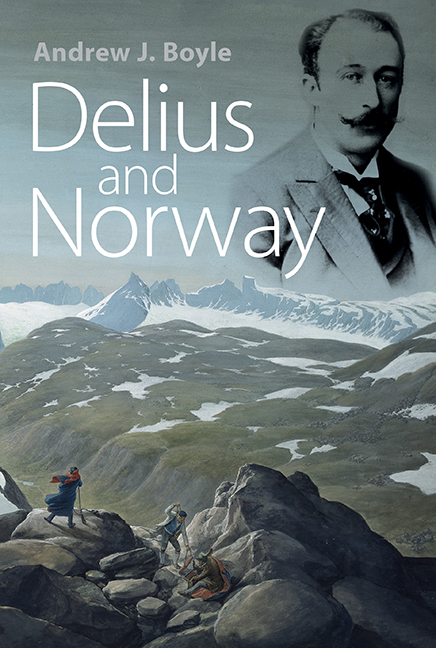Book contents
- Frontmatter
- Dedication
- Contents
- List of illustrations and tables
- Preface
- Abbreviations
- Selected glossary of landscape terms used in place names
- 1 Norway's awakening
- 2 1862–1888: Bradford, Florida and Leipzig
- 3 1888–1889: With Grieg on the heights
- 4 1890–1891: ‘C'est de la Norderie’
- 5 1892–1895: Norway lost
- 6 1896: Norway regained
- 7 1897: Front page news
- 8 1898–1902: Unshakeable self-belief
- 9 1903–1907: Breakthrough in Germany and England
- 10 1908–1912: Changes of direction
- 11 1912–1918: High hills, dark forests
- 12 1919–1934: Myth and reality in Lesjaskog
- Appendix I List of visits to Norway
- Appendix II Works with Norwegian and Danish texts and associations
- Selected bibliography and archival sources
- Index
7 - 1897: Front page news
Published online by Cambridge University Press: 30 August 2017
- Frontmatter
- Dedication
- Contents
- List of illustrations and tables
- Preface
- Abbreviations
- Selected glossary of landscape terms used in place names
- 1 Norway's awakening
- 2 1862–1888: Bradford, Florida and Leipzig
- 3 1888–1889: With Grieg on the heights
- 4 1890–1891: ‘C'est de la Norderie’
- 5 1892–1895: Norway lost
- 6 1896: Norway regained
- 7 1897: Front page news
- 8 1898–1902: Unshakeable self-belief
- 9 1903–1907: Breakthrough in Germany and England
- 10 1908–1912: Changes of direction
- 11 1912–1918: High hills, dark forests
- 12 1919–1934: Myth and reality in Lesjaskog
- Appendix I List of visits to Norway
- Appendix II Works with Norwegian and Danish texts and associations
- Selected bibliography and archival sources
- Index
Summary
‘the most unpopular man in Norway’
Delius, as described in Verdens Gang, 23 October 1897For a whole month in October and November 1897, Delius would be front page news in Norway on account of the scandal he caused with his music for the theatre comedy Folkeraadet. At the start of the year he had also kept the gossip columnists and headline writers of the New York press busy.
For several years, the composer had indulged in an affair with one of the most beautiful of Parisian aristocrats. Born Marie Léonie Mortier de Trévise in 1866, she had been married since 1888 to the Prince of Cystria, Baron de Faucigny-Lucinge. A child of the Belle Époque, she was more attracted to the cultural life of the great city than to her family's grand estate, which she was destined to inherit. A proficient singer herself, the Princesse de Cystria attracted the leading musicians of Paris to her salons, including Ravel and Debussy. Her love for Delius seems to have been genuine and enduring and it led to her accompanying him and Halfdan Jebe on their journey to Florida in 1897. In his 1959 biography of the composer, Thomas Beecham relates that for Delius the expedition was in part a way for him to flee the princess's obsessive attentions, and that she disguised herself as a man, stole on to the ship, and only disclosed her identity ‘[four] hundred miles out at sea, and six full days to run before reaching the haven of New York’. It is a beguiling version of the events that has been repeated in Delius biographies since. Nevertheless, it is a narrative that more than likely was invented by Delius at some later date to make the participation of the princess in the America trip easier to swallow for Jelka. The sources reveal a different course of events which – for elements of farce, masquerade and prankish mischief – trounces the invented version by a good margin.
Far from being a disguised and secret passenger, the Princesse de Cystria boarded the liner New York in Southampton together with Delius and Jebe.
- Type
- Chapter
- Information
- Delius and Norway , pp. 133 - 169Publisher: Boydell & BrewerPrint publication year: 2017

